AWS_CLF-C01 Exam
Volume: 325 Questions
Question No:1
Which statement is true about AWS Config and Regions?
A. AWS Config can only be used in one Region at a time
B. AWS Config is a Global service, once enabled it will work across all supported regions
automatically
C. AWS Config is not enabled at a Region level
D. AWS Config is a Region specific service, meaning it has to be configured in every region you
wish to use it
Answer: D
Explanation: AWS Config is Region specific, meaning that if you have resources in multiple
regions then you will have to configure AWS Config for each Region you want to record resource
changes. When doing so, you are able to specify different options for each Region. For example,
you could configure Config in one Region to record all supported resources across all services
within that Region, and add a predefined AWS Managed Config rule that will check if EBS
volumes are encrypted. In another Region you could select to only record a specific type of
resource, such as Security Groups with no predefined rules allocated.
Reference: http://docs.aws.amazon.com/config/latest/developerguide/gs-console.html
Question No:2
AWS uses the term
easily, with minimal friction.
to describe the ability to scale computing resources up and down
A. Scalable
B. Flexible
C. Elastic
D. Large-scale
Answer: C
Explanation: Amazon AWS is based on the concept of elasticity: it means that you can use
�
AWS_CLF-C01 Exam
instances and other AWS resources without any restrictions on scalability or limits on the
amount of available resources.
Reference: http://aws.amazon.com/ec2/
Question No:3
When does the billing process for an Amazon EC2 system begin?
A. It starts when the Amazon EC2 transitions to the running state.
B. It starts when the Status column for your distribution changes from Creating to Deployed.
C. It starts when your instance reaches 720 instance hours.
D. It starts as soon as you click the create instance option on the main EC2 console.
Answer: A
Explanation: Billing commences when Amazon EC2 initiates the boot sequence of an AMI
instance. Billing ends when the instance terminates, which could occur through a web services
command, by running "shutdown -h", or through instance failure. When you stop an instance,
Amazon shuts it down but doesn't charge per-second or per-hour usage for a stopped instance,
or data transfer fees, but charges for the storage for any Amazon EBS volumes.
Reference: http://aws.amazon.com/ec2/faqs
Question No:4
Which other AWS service can you use to enable greater security of your CloudTrail log files?
A. Key Management Service (KMS)
B. Simple Notification Service (SNS)
C. CloudWatch
D. Simple Storage Service (S3)
Answer: A
Explanation: The use of AWS KMS is an optional element of CloudTrail, but it allows additional
encryption to be added to your Log files when stored on S3
Reference: http://docs.aws.amazon.com/kms/latest/developerguide/services-cloudtrail.html
�
AWS_CLF-C01 Exam
Question No:5
Your customers are concerned about the security of their sensitive data and their inquiry asks
about what happens to old storage devices on AWS. What would be the best answer to this
question?
A. AWS uses the techniques detailed in DoD 5220.22-M to destroy data as part of the
decommissioning process.
B. AWS uses a 3rd party security organisation to destroy data as part of the decommissioning
process.
C. AWS uses their own proprietary software to destroy data as part of the decommissioning
process.
D. AWS reformats the disks and uses them again.
Answer: A
Explanation: When a storage device has reached the end of its useful life, AWS procedures
include a decommissioning process that is designed to prevent customer data from being
exposed to unauthorized individuals.
AWS uses the techniques detailed in DoD 5220.22-M (“National Industrial Security Program
Operating Manual “) or NIST 800-88 (“Guidelines for Media Sanitization”) to destroy data as part
of the decommissioning process.
All decommissioned magnetic storage devices are degaussed and physically destroyed in
accordance with industry-standard practices.
Reference: https://d0.awsstatic.com/whitepapers/aws-security-whitepaper.pdf
Question No:6
You have been handed a new scope of work from your manager which involves migrating an
on-premise application architecture to AWS. During your design process you have to give
consideration to current on-premise security and determine which security attributes you are
responsible for on AWS and which is the responsibility of AWS. Which of the following is the
responsibility of AWS as part of the shared responsibility model? (Choose 3 answers)
A. Virtualization infrastracture
B. Edge Locations
C. Data Center Hardware
D. Client side Encryption
�
AWS_CLF-C01 Exam
Answer: A,B,C
Explanation: While AWS manages security of
the cloud, security in the cloud is the
responsibility of the customer. Customers retain control of what security they choose to
implement to protect their own content, platform, applications, systems and networks, no
differently than they would for applications in an on-site datacenter.
Reference: https://aws.amazon.com/compliance/shared-responsibility-model/
Question No:7
access and at what level
is the process in which a system you have authenticated to establishes what you can
A. Verification
B. Authorisation
C. Authentication
D. Access Control
Answer: B
Explanation: So here we are really looking at your access privileges and permissions. If for
example you logged into an AWS account, you would have authenticated yourself by providing
the correct identity and password, now AWS security features, and in this case AWS IAM,
(Identity & Access Management service), defines the level of authorised access assigned to that
identity within the AWS environment. Each identity can have a different level of authorisation
properties associated to it. It’s these properties that determine what that identity can then
access.
Question No:8
In regards to AWS infrastructure, a(n)
cache data and reduce latency.
is deployed in highly populated areas to
A. availability zone
B. edge location
C. data center
D. region
�
AWS_CLF-C01 Exam
Answer: B
Explanation: Edge Locations are AWS sites deployed in major cities and highly populated areas.
Edge Locations are not used to deploy your main infrastructures. Instead they are used by AWS
services such as AWS CloudFront to cache data and reduce latency for end user access.
Reference: https://d0.awsstatic.com/whitepapers/AWS_Cloud_Best_Practices.pdf
Question No:9
Which of the following is not a pillar of the Well-Architected Framework developed by AWS?
A. Security
B. Performance Efficiency
C. Profitability
D. Operational excellence
Answer: C
Explanation: To understand the elements of the well-architected framework you must be aware
of the 5 pillars that that the framework is based and built upon:
. Operational excellence
. Security
. Reliability
. Performance efficiency
. Cost optimization
Reference:
https://d1.awsstatic.com/whitepapers/architecture/AWS_Well-Architected_Framework.pdf
Question No:10
Which of the following statements best describes Amazon Cognito?
A. It is an AWS Storage & Content Delivery System
B. It is a new AWS database
C. It is a simple user-data synchronization and identity service that helps you securely manage
and synchronize app data for your users across their mobile devices.
D. It is an AWS Deployment & Management System
�
AWS_CLF-C01 Exam
Answer: C
Explanation: Amazon Cognito is a simple user-data synchronization and identity service that
helps you securely manage and synchronize app data for your users across their mobile devices.
You can create unique identifiers for your users through a number of public login providers
(Amazon, Facebook, Google or any OpenID Connect compatible provider), or your own user
identity system, and also support unauthenticated guests. You can save app data locally on the
device allowing your apps to work even when the device is offline and then securely sync and
save this data to the AWS cloud, and all of a user’s devices.
Reference: http://aws.amazon.com/cognito/faqs/
Question No:11
A user has archived data from Amazon S3 to Amazon Glacier. How much data can be restored by
the user for free every month?
A. 5% of archived data
B. The entire volume of data
C. 20% of archived data
D. 15% of archived data
Answer: A
Explanation: When a user has archived an object from S3, the user can restore it only from the
S3 console. Glacier charges the user only based on the peak billable rate. The user can restore
up to 5% of the archived data free of cost. AWS first calculates the peak billable rate and then
based on that calculates the cost of transfer. It never calculates the cost based on the age of the
archive.
Reference:
http://aws.amazon.com/s3/faqs/#How_will_I_be_charged_when_restoring_large_amounts_of_
data_from_Amazon_Glacier
Question No:12
How is Key Management Service (KMS) priced?
A. KMS is priced per number of encryption/decryption requests received from all services per
month.
B. KMS is priced per data encryption keys; you are charged for the number of individual data
�
AWS_CLF-C01 Exam
keys maintained in KMS.
C. KMS is priced per customer master key and the number of requests received per month.
D. KMS is priced per customer master key; you are charged for the number of master keys
maintained in KMS.
Answer: C
Explanation: KMS is priced per two factors: the number of Customer Master Keys maintained in
KMS and the number of requests received within a month.
Question No:13
What specific type of budgets does AWS budgets not allow you to create?
A. Data transfer
B. Usage
C. Cost
D. Reserved instance utilization
Answer: A
Explanation: Three budget types are available - cost, usage, and reserved instance utilization.
Data transfer is not a specific budget type, but the cost related to data transfers would be
monitored under the cost budgets.
Reference:
https://docs.aws.amazon.com/awsaccountbilling/latest/aboutv2/budgets-managing-costs.ht
ml
Question No:14
An Amazon Machine Image (AMI) can be best described as a
.
A. preconfigured template for your instances
B. a virtual machine backup file on a local server hard drive
C. a temporary virtual machine created during horizontal scaling
�
AWS_CLF-C01 Exam
D. VMware configuration file for any network deployment
Answer: A
Explanation: Amazon EC2 provides Amazon Machine Images (AMIs), which are preconfigured
templates for your instances.
Reference: http://docs.aws.amazon.com/gettingstarted/latest/awsgsg-intro/awsgsg-intro.pdf
Question No:15
How does AWS define cloud computing?
A. The on-demand delivery of IT resources through a cloud services platform via the Internet
with pay-as-you-go pricing.
B. The term used to describe virtualized technology.
C. A physical pool of compute, storage and network resources that can’t be accessed over the
internet.
D. A pool of servers offering compute resources that are designed to be issued exclusively to
individual tenants (users and organizations).
Answer: A
Explanation: Cloud computing provides a simple way to access servers, storage, databases and
a broad set of application services over the Internet. A cloud services platform such as Amazon
Web Services owns and maintains the network-connected hardware required for these
application services, while you provision and use what you need via a web application.
Reference: https://d0.awsstatic.com/whitepapers/aws-overview.pdf
Question No:16
What does the phrase 'stop guessing capacity' mean?
A. To set correct data storage lifecycles
B. To use elastic IP addresses to increase high availability
C. Use of auto scaling to prevent the need to predict and guess your capacity and demand
requirement
D. To implement self-healing processes
�
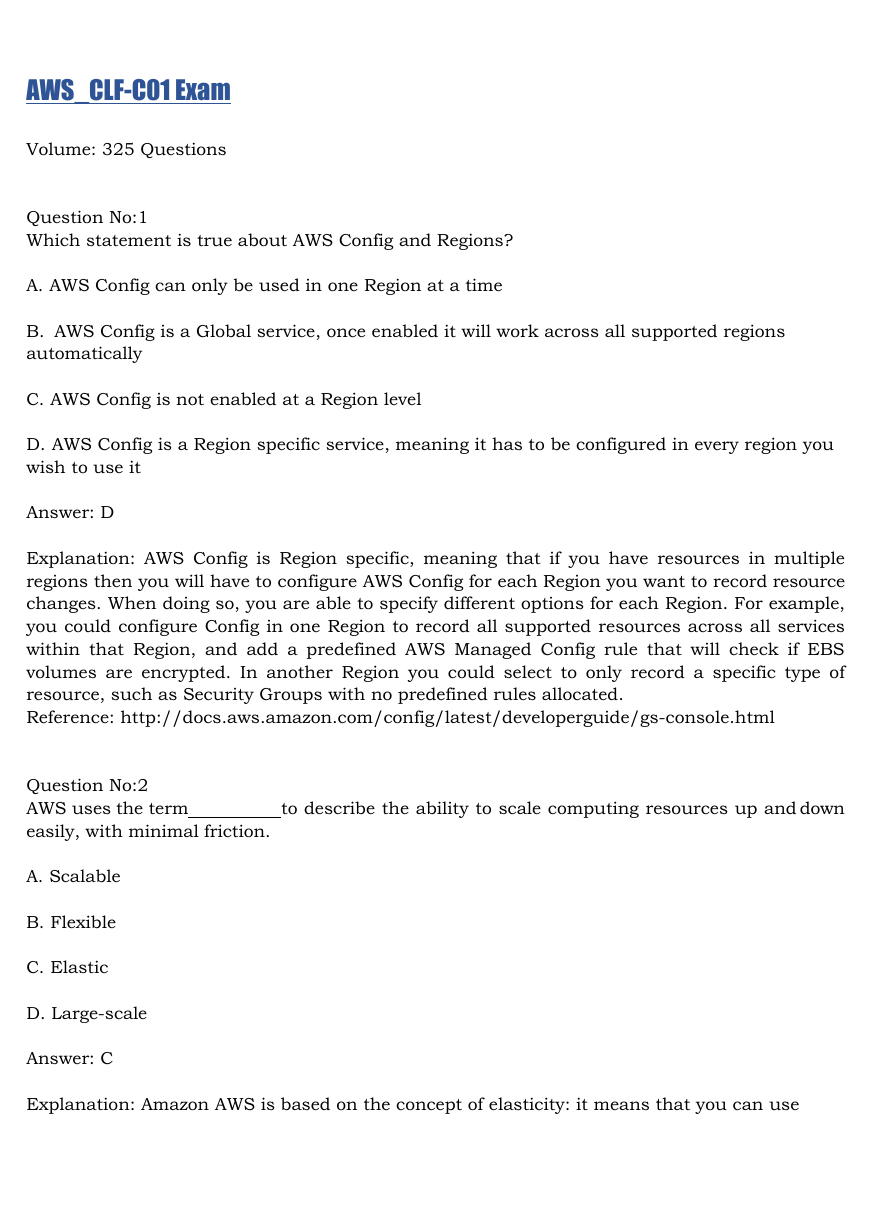
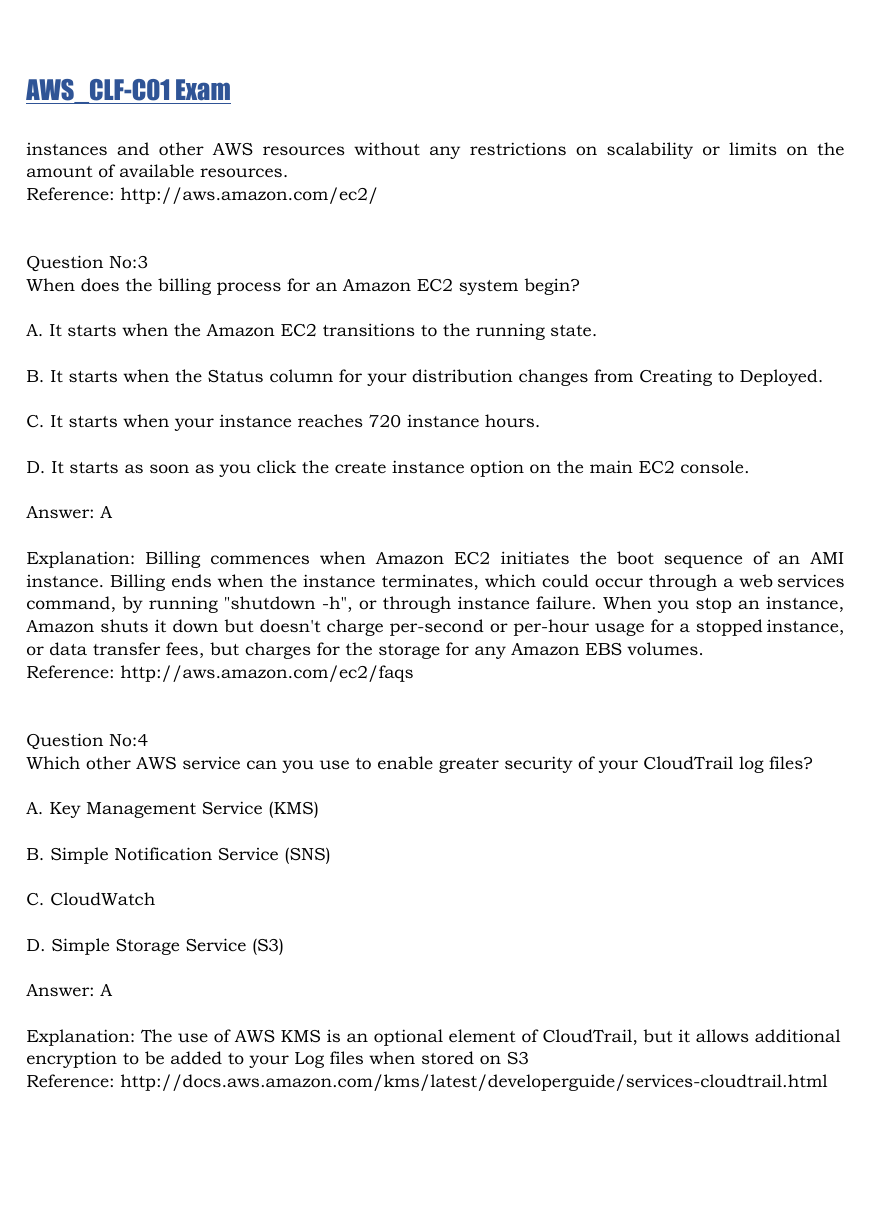
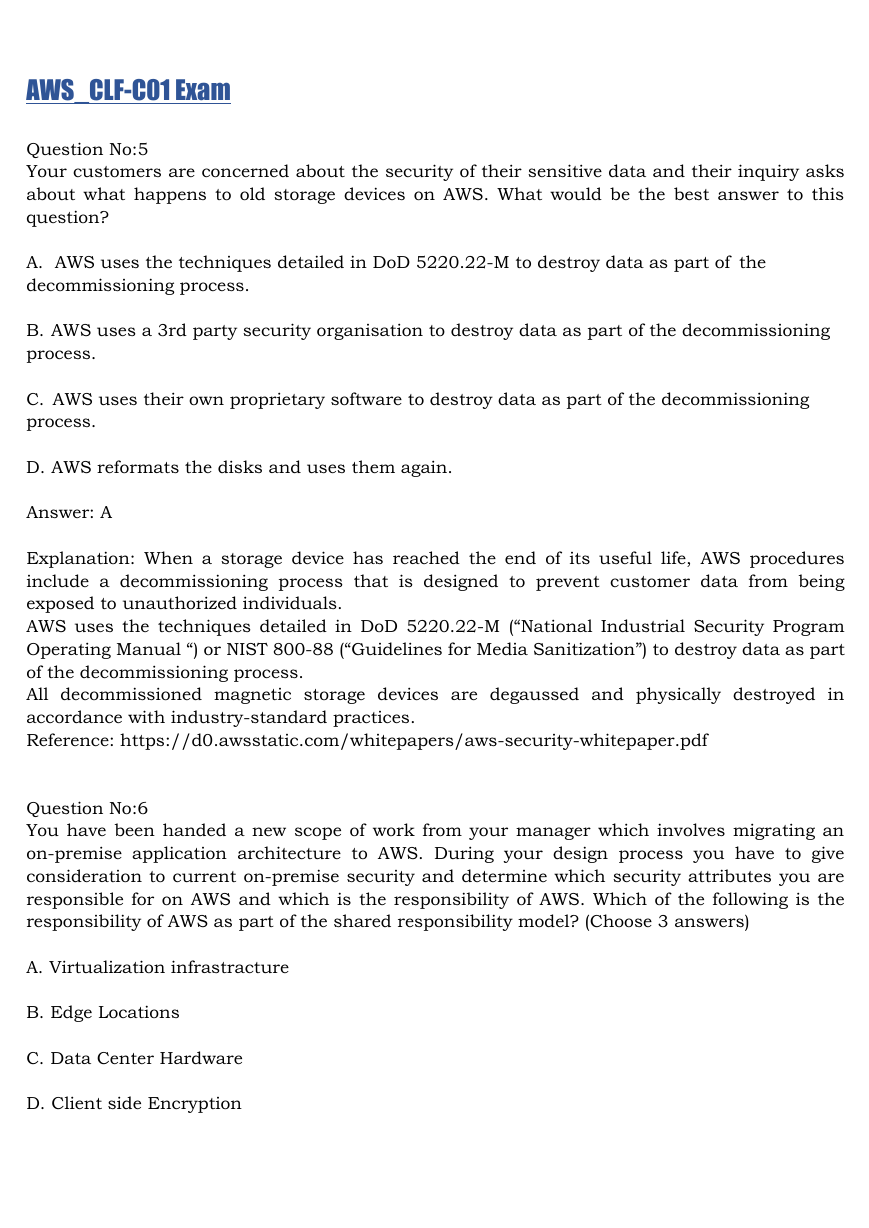
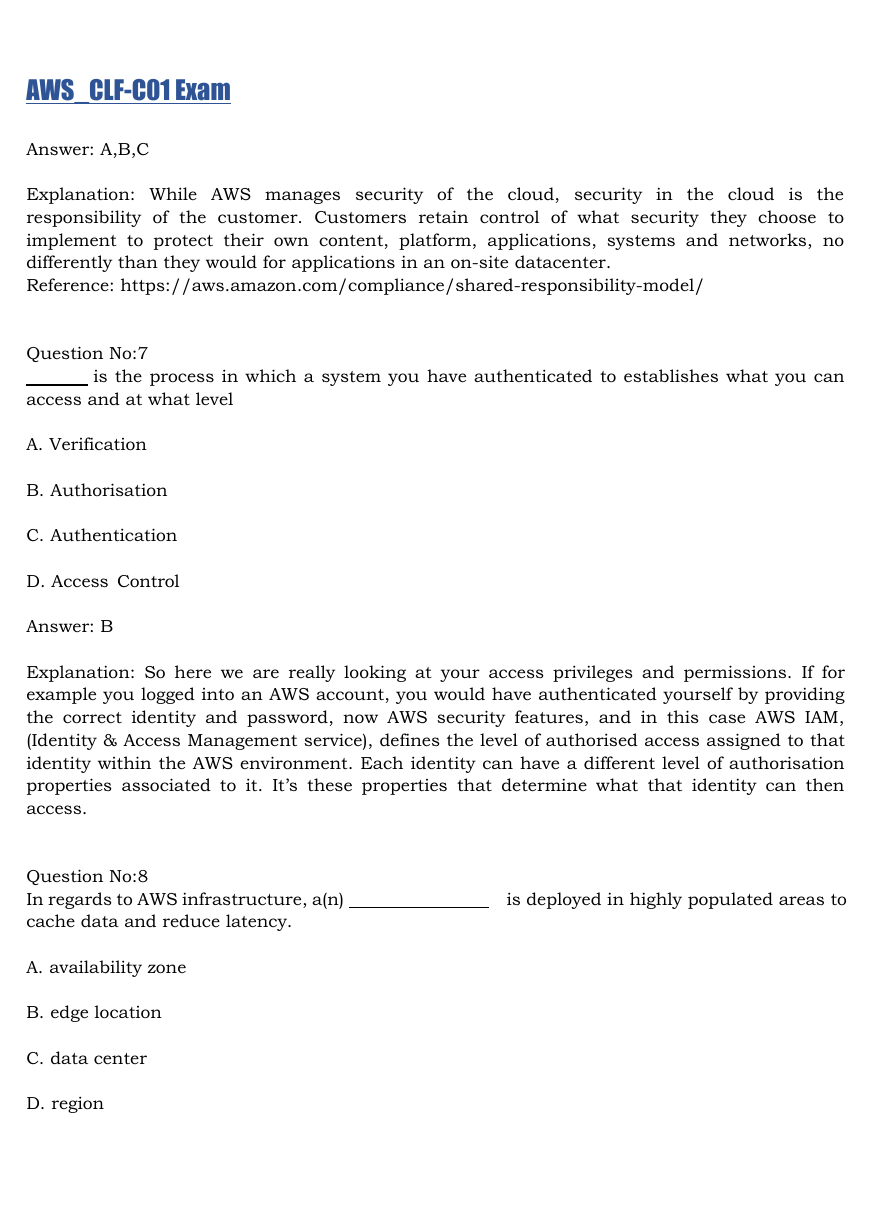
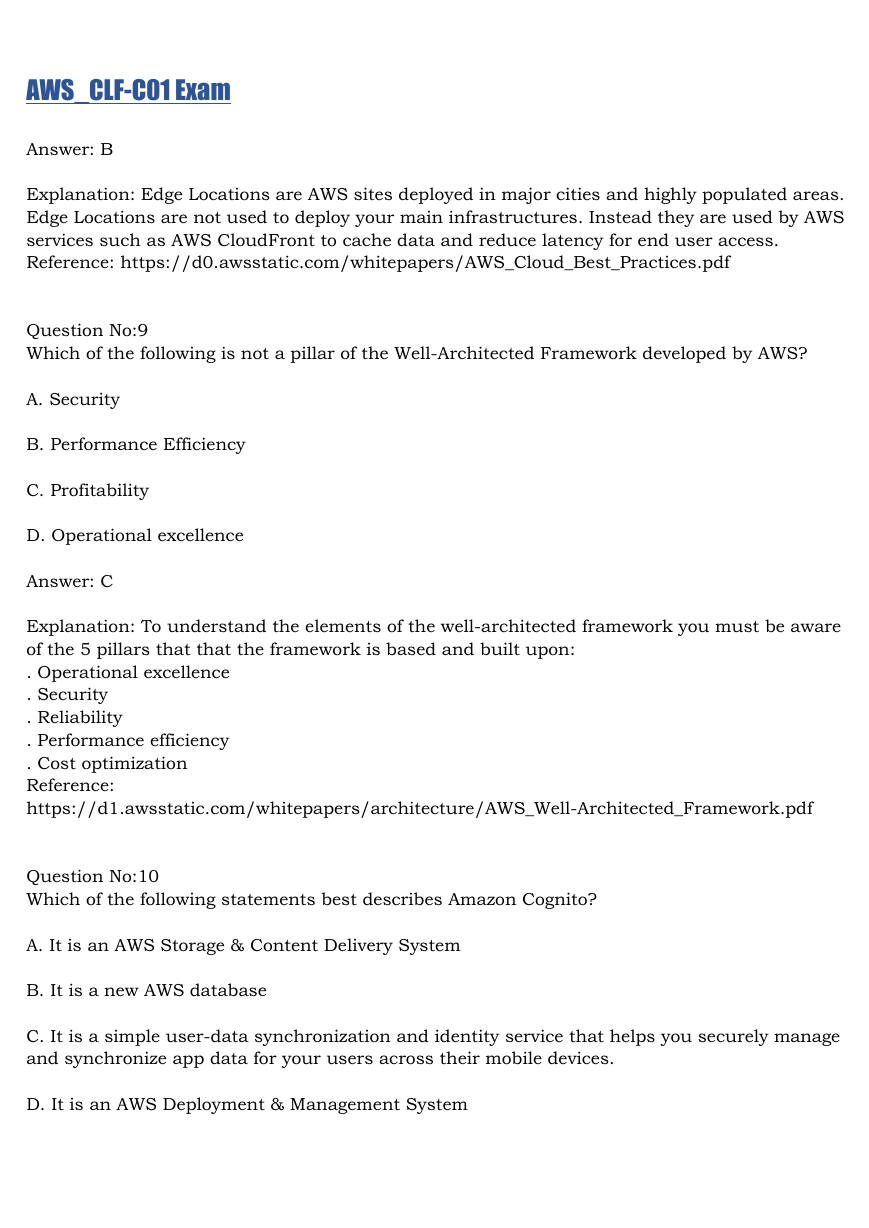
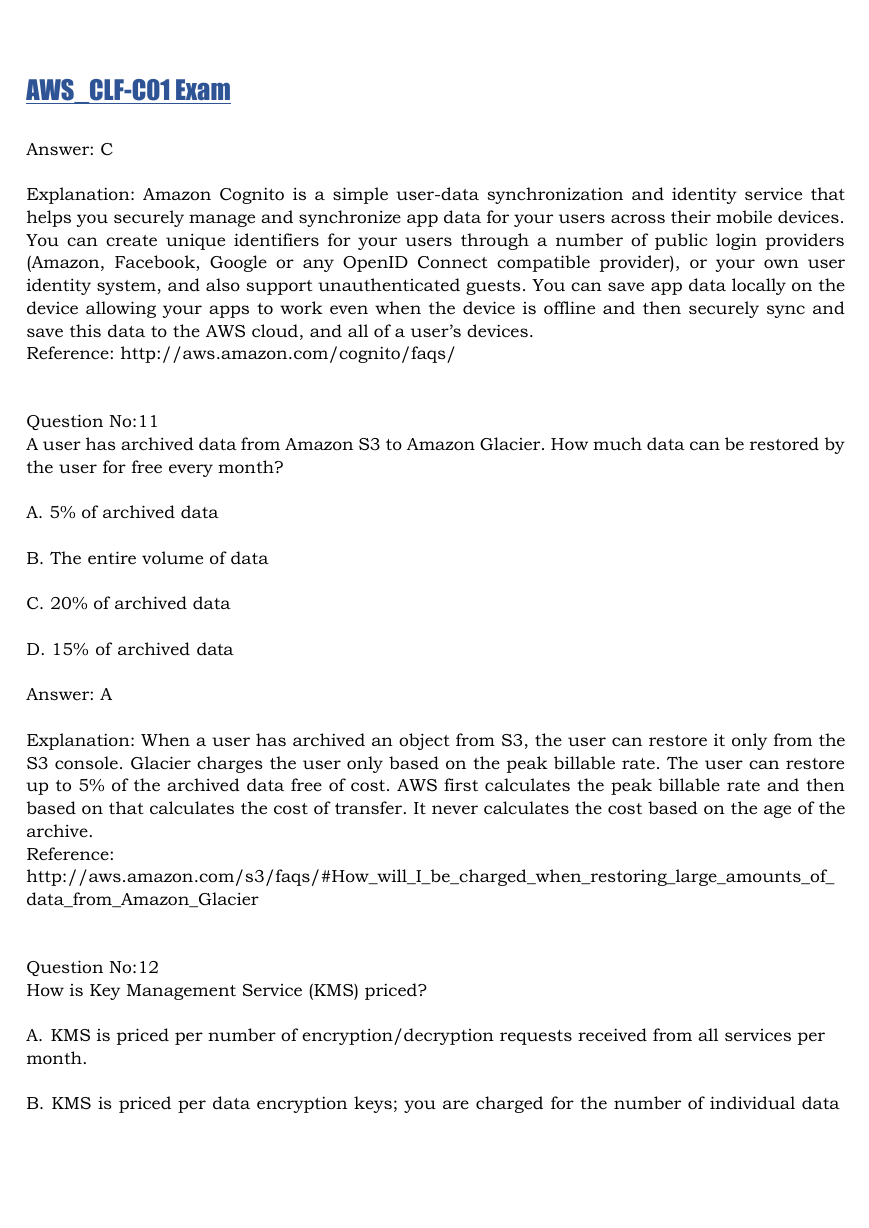
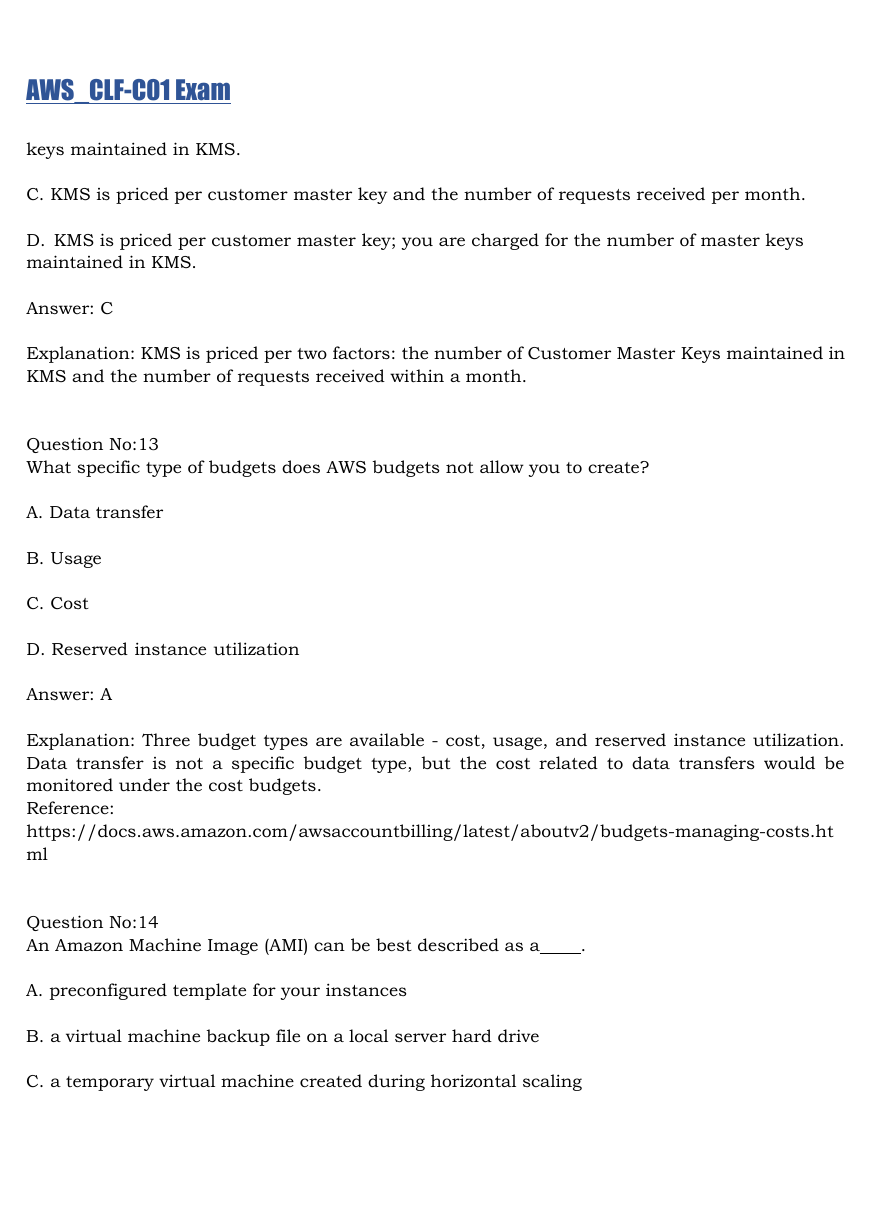
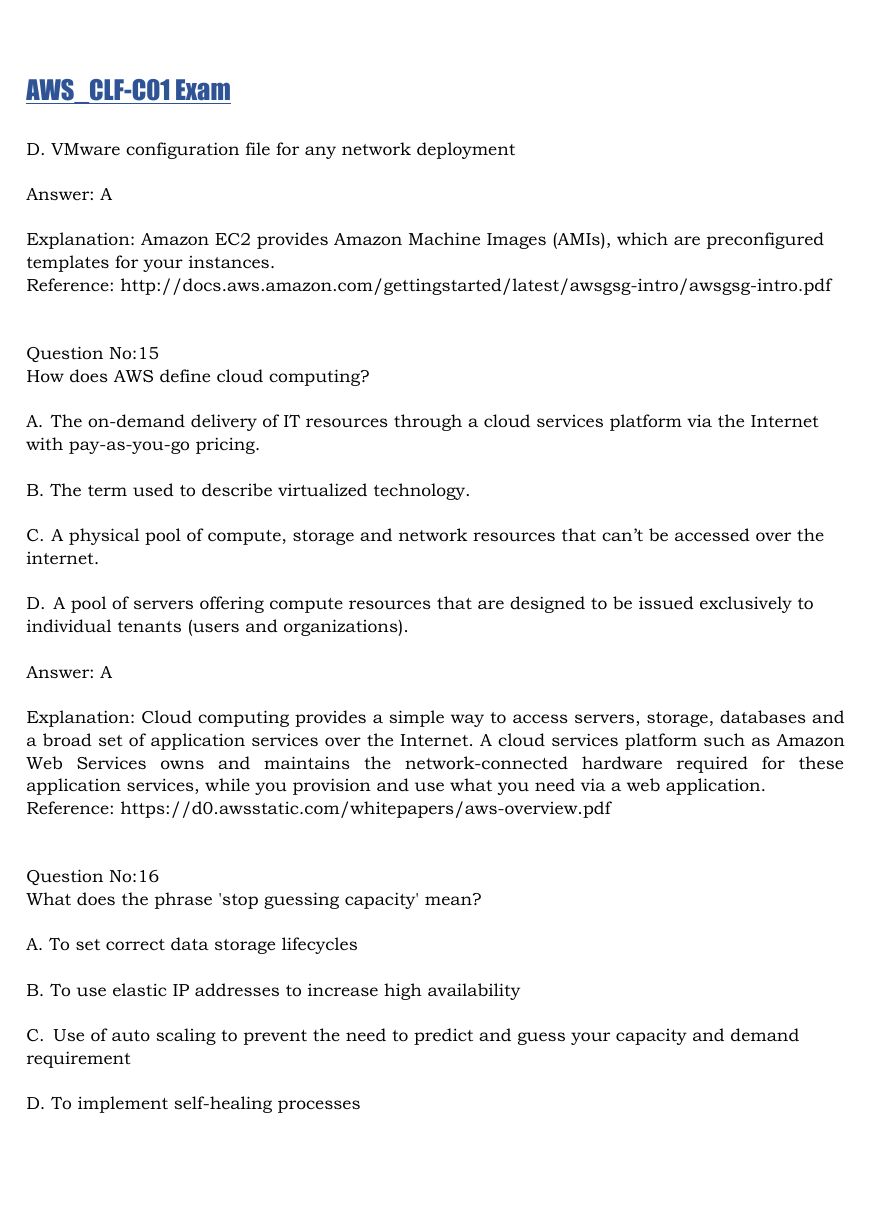








 2023年江西萍乡中考道德与法治真题及答案.doc
2023年江西萍乡中考道德与法治真题及答案.doc 2012年重庆南川中考生物真题及答案.doc
2012年重庆南川中考生物真题及答案.doc 2013年江西师范大学地理学综合及文艺理论基础考研真题.doc
2013年江西师范大学地理学综合及文艺理论基础考研真题.doc 2020年四川甘孜小升初语文真题及答案I卷.doc
2020年四川甘孜小升初语文真题及答案I卷.doc 2020年注册岩土工程师专业基础考试真题及答案.doc
2020年注册岩土工程师专业基础考试真题及答案.doc 2023-2024学年福建省厦门市九年级上学期数学月考试题及答案.doc
2023-2024学年福建省厦门市九年级上学期数学月考试题及答案.doc 2021-2022学年辽宁省沈阳市大东区九年级上学期语文期末试题及答案.doc
2021-2022学年辽宁省沈阳市大东区九年级上学期语文期末试题及答案.doc 2022-2023学年北京东城区初三第一学期物理期末试卷及答案.doc
2022-2023学年北京东城区初三第一学期物理期末试卷及答案.doc 2018上半年江西教师资格初中地理学科知识与教学能力真题及答案.doc
2018上半年江西教师资格初中地理学科知识与教学能力真题及答案.doc 2012年河北国家公务员申论考试真题及答案-省级.doc
2012年河北国家公务员申论考试真题及答案-省级.doc 2020-2021学年江苏省扬州市江都区邵樊片九年级上学期数学第一次质量检测试题及答案.doc
2020-2021学年江苏省扬州市江都区邵樊片九年级上学期数学第一次质量检测试题及答案.doc 2022下半年黑龙江教师资格证中学综合素质真题及答案.doc
2022下半年黑龙江教师资格证中学综合素质真题及答案.doc